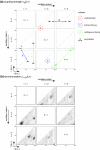A method for the estimation of functional brain connectivity from time-series data
- PMID: 21629586
- PMCID: PMC2866368
- DOI: 10.1007/s11571-010-9107-z
A method for the estimation of functional brain connectivity from time-series data
Abstract
A central issue in cognitive neuroscience is which cortical areas are involved in managing information processing in a cognitive task and to understand their temporal interactions. Since the transfer of information in the form of electrical activity from one cortical region will in turn evoke electrical activity in other regions, the analysis of temporal synchronization provides a tool to understand neuronal information processing between cortical regions. We adopt a method for revealing time-dependent functional connectivity. We apply statistical analyses of phases to recover the information flow and the functional connectivity between cortical regions for high temporal resolution data. We further develop an evaluation method for these techniques based on two kinds of model networks. These networks consist of coupled Rössler attractors or of coupled stochastic Ornstein-Uhlenbeck systems. The implemented time-dependent coupling includes uni- and bi-directional connectivities as well as time delayed feedback. The synchronization dynamics of these networks are analyzed using the mean phase coherence, based on averaging over phase-differences, and the general synchronization index. The latter is based on the Shannon entropy. The combination of these with a parametric time delay forms the basis of a connectivity pattern, which includes the temporal and time lagged dynamics of the synchronization between two sources. We model and discuss potential artifacts. We find that the general phase measures are remarkably stable. They produce highly comparable results for stochastic and periodic systems. Moreover, the methods proves useful for identifying brief periods of phase coupling and delays. Therefore, we propose that the method is useful as a basis for generating potential functional connective models.
Keywords: Functional connectivity; MEG magnetencephalography; Network analysis; Time-delayed phase synchronization.
Figures








References
-
- Angelini L, Pellicoro M, and Stramaglia S (2009) Granger causality for circular variables. Phys Lett A 373(29):2467–2470. doi:10.1016/j.physleta.2009.05.009
-
- Benjamini Y, Hochberg Y. Controlling the false discovery rate: a practical and powerful approach to multiple testing. J R Stat Soc Series B Methodol. 1995;57(1):289–300.
LinkOut - more resources
Full Text Sources

